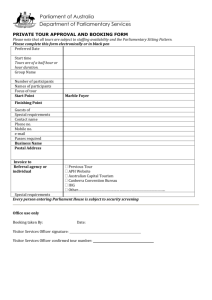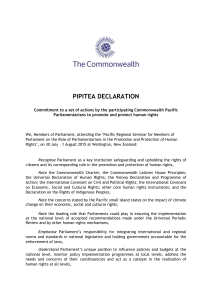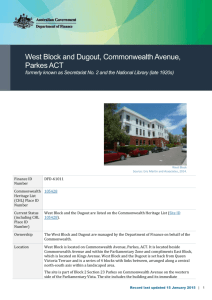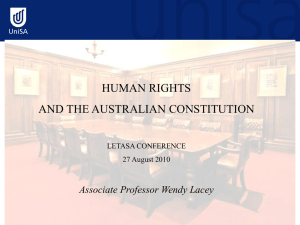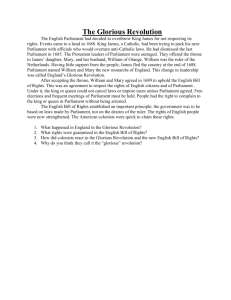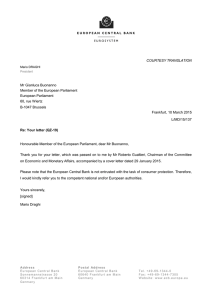East Block Government Offices, Queen Victoria Terrace, Parkes ACT
advertisement
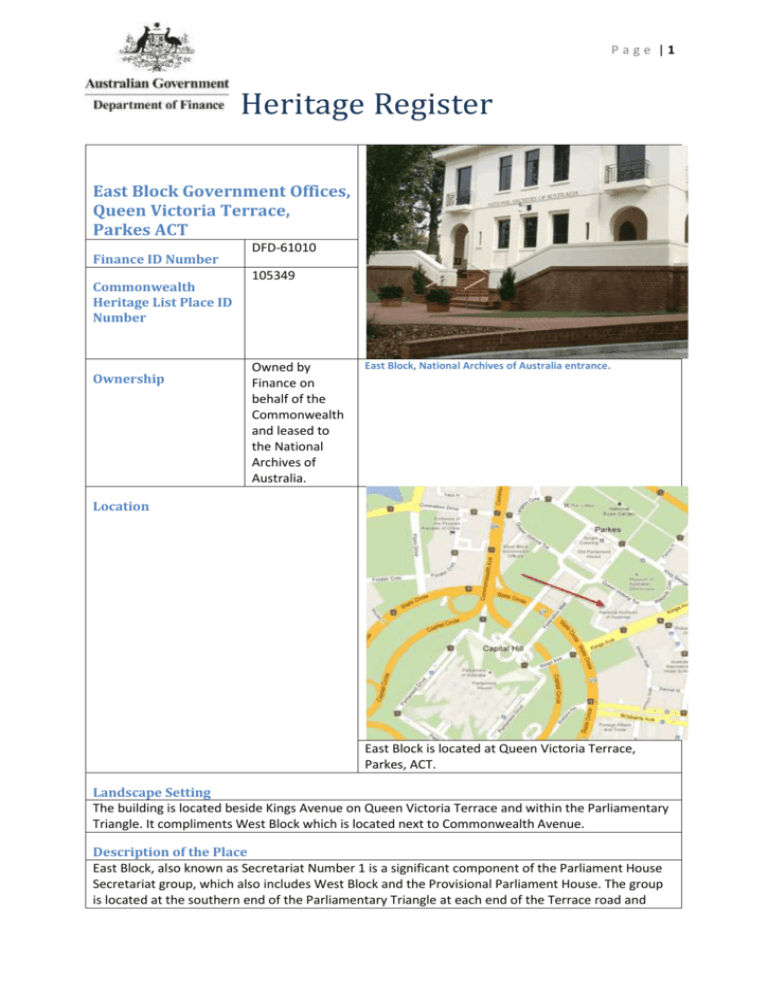
Page |1 Heritage Register East Block Government Offices, Queen Victoria Terrace, Parkes ACT Finance ID Number Commonwealth Heritage List Place ID Number Ownership DFD-61010 105349 Owned by Finance on behalf of the Commonwealth and leased to the National Archives of Australia. East Block, National Archives of Australia entrance. Location East Block is located at Queen Victoria Terrace, Parkes, ACT. Landscape Setting The building is located beside Kings Avenue on Queen Victoria Terrace and within the Parliamentary Triangle. It compliments West Block which is located next to Commonwealth Avenue. Description of the Place East Block, also known as Secretariat Number 1 is a significant component of the Parliament House Secretariat group, which also includes West Block and the Provisional Parliament House. The group is located at the southern end of the Parliamentary Triangle at each end of the Terrace road and Page |2 forms essential and important axial planning element with the Parliamentary Triangle. The Parliament Secretariat group (including East Block) was designed by the Chief Commonwealth Architect, John Smith Murdoch to accommodate public servants required to support the Parliament which was moved to Canberra in 1927. It also housed the first Post Office and Telephone Exchange associated with the move of the Parliament to Canberra. East Block is a fine example of Inter-War Stripped Classical style which became known as Federal Capital architecture. The building was designed on a 21ft x 14ft grid and a ‘H’ form to maximise natural light and ventilation. Its structure is load bearing brickwork with timber internal structure. The Secretariat Buildings were not designed as exact mirror images; each building was articulated in a classical composition of three blocks, symmetrically disposed to the east and west Land Axis. The architectural language of the two buildings are identical, using the same materials, repeating the same elements, proportions and details. The main entrances to the centre blocks are located on an east west axis perpendicular to the Land Axis. East Block is symmetrical in plan, with a three storey central section and two storey blocks on each side. It has a brick base with a painted rendered finish above ground floor level. The fenestration has a strong pattern of vertical proportions and a symmetrical distribution. Arcaded entrance screens to the centre block from a dignified courtyard arrival point to the building. A strong cornice line defines the two storey blocks with parapets above, articulating the separation between the three storey section and the outer wings of the complex. Although alterations and replacements to original fabric have taken place, the integrity of the building is still of a high order externally, and the building is well maintained. Extensions to the building occurred in 1937 and 1943 which included extra space for the telephone Exchange. The Post Office façade was modernized in 1953 and internal upgrading was undertaken. The main changes to the building are the enclosure of the corner balconies, D Block extension and the alterations to the north façade. Except for two original stairs, little internal original fabric remains. The external fabric is substantially intact. History and Summary of Uses of the Place East Block is located on the traditional lands of the Ngunnawal people and their descendants continue to live in Canberra and the surrounding region. With the federation of the Australian colonies in 1901 began a long process to establish the national capital, with the land around the Canberra area formally acquired in 1911 and the international competition for the design of the new city finalized in 1912. The Canberra Secretariat buildings (including East Block) and the Provisional Parliament House were the first buildings designed and erected in the Parliamentary Triangle of the new Federal Capital. The architectural nature of these buildings was quite different from the buildings envisaged for the Parliamentary Triangle by Walter Burley Griffin, the young American architect who won the international competition held in 1912, for the design of Canberra. After World War 1, ideas of monumental grandeur could no longer be supported because of heavy war expenditure. The Federal Capital Advisory Committee favoured “utilisation development and economy” in a “garden town, with simple, pleasing and unpretentious buildings”. The project for a provisional Parliament House was given to the Commonwealth Architect, John Smith Murdoch. Page |3 The first proposal for accommodation of administrative staff to support the transfer of Parliament to Canberra was considered by the Parliamentary Standing Committee on Public Works in 1923. The committee recommended permanent administration offices be built; however it was recognised that permanent administration offices could not be completed for the first session of Parliament. The Secretariat Scheme was suggested as a way out of the difficulties of synchronising the design and construction of permanent administration building with the opening of the provisional Parliament house and the first session of Parliament in Canberra. The Advisory Committee suggested that the transfer of Departments to Canberra be modified, and that instead of having Departments as a whole – a Secretariat or nucleus of each Department be temporarily established, sufficient to assist the Minister with Parliamentary work and to provide a link between the work and the general administration of Departments in Melbourne. This was accepted by the Minister and plans were prepared for two suitable building, Secretariat No. 1 (East Block) and Secretariat No. 2 (West Block), which would be located one on either side of the main city axis, to the south west of Parliament House. The East Block proposal included a Secretariat Building at Canberra with provision for an Automatic telephone Exchange and Post Office. The centre block was to provide office accommodation for officials whose attendance at Canberra was essential by the time parliament assembled. The Post Office and Telephone Exchange, to the north and south respectively of the centre blocks were serves essential to the function of a modern parliament. East Block was completed first and the Post Office and telephone Exchange we up and running for the arrival of the first wave of Departmental Officers from the Department of Trade and Customs. As Canberra's main post office, it had the post code 2600 and all distances to Canberra were measured from it. Of special interest is the pneumatic tube system, installed in 1940, which assisted communications between East Block and Old Parliament House. From 1937-43 the Post Office in East Block was squared off by infill additions and, over the same period, additions to the west and to the south were made for the Telephone Exchange. Underground pneumatic tubes, were used to ferry correspondence back and forth between the Provisional Parliament House and East Block. (Remnants of these survive in the basement.) Utilities and public spaces were upgraded in 1982. The air conditioning system was upgraded and a new plant room located at the first floor of the original Telephone Exchange building. The centre block, the Telephone Exchange building and the offices built in 1937 were reroofed in metal decking. Other refurbishments occurred in the entry and office interiors. By 1994 East Block was under the administration of the Department of Arts and Administration Services. The former Post Office area was refurbished and opened in 1998 as the public area of the National Archives with a gallery for exhibitions. The refurbishment involved adaptation of the northern facade, including demolition of a 1950s addition, and the construction of ramps and disabled access. A section of pneumatic tube which connected the East Block to the provisional Parliament House has been retained to demonstrate the connection between the Secretariat Building and the former Parliament House. Page |4 Statutory Heritage Values Commonwealth Heritage List John Smith Murdoch East Block has played an important role as the first Post Office in Canberra. Source: Conservation Management Plan 1995 East Block Government Offices is a Commonwealth Heritage place and is protected under the Environment Protection and Biodiversity Conservation Act 1999. Statement of Significance East Block is a significant component of the Parliament House Secretariat group, which also includes West Block and the Provisional Parliament House. The group is located at the southern end of the Parliamentary Triangle and is an integral component of the significant Parliamentary Triangle landscape, exhibiting the skilful handling of planning and architectural forms within a simply designed landscape of related buildings, spaces and plantings. The group is an essential and important axial planning element within the Parliamentary Triangle. The planning principles of the group are as established by Walter Burley Griffin, and the architectural resolution of the group is as established within the office of John Smith Murdoch, Director of Works. East Block is important for its association with Federation, as part of the Provisional Parliament House group, which formed the essential Government facilities in the early development of Canberra as the Nation's Capital. The Secretariat buildings are a remnant of the relocation phase of the Federal Capital when they represented the seat of Federal Government and political power. The former Secretariat buildings demonstrate a model of Government Administration dating from the earliest periods of developing the National Capital in the mid 1920s. East Block also accommodated the first Post Office for Canberra, servicing the City as well as the Parliament, and accommodated the first telephone exchange. The building was designed within the office of John Smith Murdoch and is a fine example of Inter-War Stripped Classical style which became known as Federal Capital architecture. This is represented by the symmetrical planning and form, its classical proportions, the low horizontal massing, the simple but dignified detailing (such as cornices, balustrades, rainwater heads and paving) and its good appearance from all sides. East Block is an example of the Inter-War Stripped Classical Style Criterion A Process The building has associations with the relocation phase of the Federal Capital, the planning and architecture of John Smith Murdoch and Walter Burley Griffin, and the evolution of Federal Government administration in Canberra. The basement pneumatic tube for sending and receiving correspondence between East Block and Old Parliament House is of exceptional interest. Gazetted Commonwealth Heritage values East Block is important for its association with Federation, as part of the Provisional Parliament House group, which formed the essential Government facilities in the early development of Canberra as the Nation's Capital. The Secretariat buildings are a remnant of the relocation phase of the Federal Capital when they represented the seat of Federal Page |5 Government and political power. The former Secretariat buildings demonstrate a model of Government Administration dating from the earliest periods of developing the National Capital in the mid 1920s. East Block also accommodated the first Post Office for Canberra, servicing the City as well as the Parliament, and accommodated the first telephone exchange. Criterion D Characteristic values Criterion F Technical achievement Attributes All of the original form, fabric and appearance of the building. Gazetted Commonwealth Heritage values The building was designed within the office of John Smith Murdoch and is a fine example of Inter-War Stripped Classical style which became known as Federal Capital architecture. This is represented by the symmetrical planning and form, its classical proportions, the low horizontal massing, the simple but dignified detailing (such as cornices, balustrades, rainwater heads and paving) and its good appearance from all sides. Attributes The building's Inter-War Stripped Classical style evidenced by the features noted above. Gazetted Commonwealth Heritage values East Block is a significant component of the Parliament House Secretariat group, which also includes West Block and the Provisional Parliament House. The group is located at the southern end of the Parliamentary Triangle and is an integral component of the significant Parliamentary Triangle landscape, exhibiting the skilful handling of planning and architectural forms within a simply designed landscape of related buildings, spaces and plantings. The group is an essential and important axial planning element within the Parliamentary Triangle. The planning principles of the group are as established by Walter Burley Griffin, and the architectural resolution of the group is as established within the office of John Smith Murdoch, Director of Works. The basement pneumatic tube for sending and receiving correspondence between East Block and Old Parliament House is of exceptional interest. Attributes The building's location in relation to West Block, Old Parliament House and the Parliamentary Triangle. Also, remnants of the pneumatic tube system. Criterion H Significant people Gazetted Commonwealth Heritage values The building has associations with the relocation phase of the Federal Capital, the planning and architecture of John Smith Murdoch and Walter Burley Griffin, and the evolution of Federal Government administration in Canberra. Attributes The building's original architectural form and detail plus its relationship to Page |6 West Block, Old Parliament House and the Parliamentary Triangle. Non-Statutory Heritage Listings Property or Information Access Restrictions or Requirements if Any Conservation Documents or References Register of the National Estate: Registered (11/08/1987) Place ID 19963 The Australian Institute of Architects – West Block Government Offices listed on Register of Significant Twentieth Century Architecture (R074) National Trust of Australia (ACT) Classified. The National Archives of Australia encourages public to use the building for access to the National Archives' collections. Royal Australian Institute of Architects, Register of Significant Twentieth Century Architecture. No R74 National Trust of Australia (ACT) (1994) Philip Cox, Richardson, Taylor & Partners (1995) East Block Final Conservation Plan, September 1994, For Australian Estate Management: In AHC File # 8/1/0/477 Peter Freeman Pty Ltd (1997) East Block Secretariat No. 1. Parkes Refurbishment and Fit out Independent Review for GE Shaw & Associates and Domestic Property Group, Department of Administrative Services. Record Last Updated 30 October 2013.
